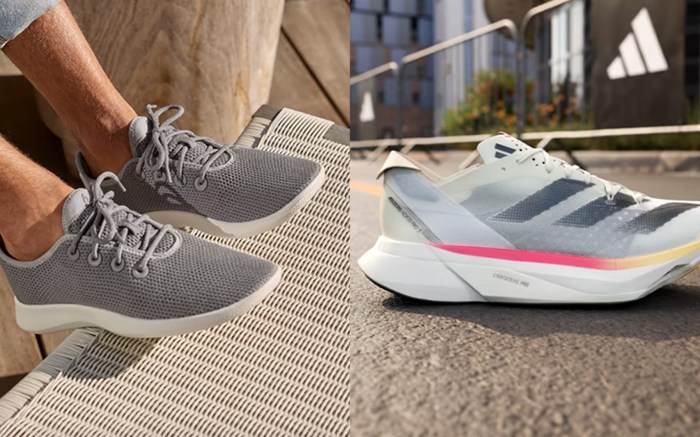If you purchase an independently reviewed product or service through a link on our website, Footwear News may receive an affiliate commission.
Like many things in 2023, the luxury fashion sneaker market found itself in a period of evolution and uncertainty amid changing consumer spending and shifting trends.
Once an all-in for luxury brands — as major players like Louis Vuitton, Gucci, Prada, Versace and Balenciaga widely adopted the silhouette into their merchandise mix — the fashion sneaker began to lose its way over the past few years thanks to a variety of factors. From a newfound emphasis on athletic brand classics and an interest in other categories like outdoor, to a slew of newer athletic powerhouses Hoka and On, many luxury houses are now uncertain of how to move the fashion needle forward when it comes to sneakers.
Looking back at the category’s roots, luxe sneakers found a renewed spark in the mid to late 2010s amid a fresh wave of creative directors who took the helm at major fashion houses and were eager to cook up innovative and never-before-seen silhouettes. Styles like the Gucci Rhyton, the Louis Vuitton Archlight and the Balenciaga Triple S were born during this time and quickly became the must-have shoes for many fashion insiders and budding social media stars.
Watch on FN
Legendary fashion designers also got in on the sneaker game. Who can remember when Karl Lagerfeld sent every model in his 2014 Chanel Haute Couture collection down the runway in sneakers?

But fast forward a few seasonal price increases later, coupled with mounting inflation and a lack of newness in the category, and consumers have seemed to move on from the chunky “dad” shoes that many sneakerheads fawned over pre-pandemic.
Designers have moved on, too — at least for now. Once the dominate category seen on model’s during seasonal catwalk presentation, many creative directors have ditched sneakers all-together. In recent women’s fashion weeks, Mary Janes and ballet flats have dominated the conversation and have ignited excitement in the segment. As for men’s designers, loafers and casual slip-on styles dominated the spring/summer 2024 collections.
The movement away from sneakers was reinforced during Milan Fashion Week Men’s this month when labels like Gucci and Prada, which once relied heavily on sneakers, did not show the silhouette at all in their fall/winter 2024 presentations.

What Industry Analysts Are Saying
This seemingly overnight cooling off of the category has been going on for some time now. In fact, many experts believe sales in luxury sneakers may have hit its peak during the pandemic.
According to Beth Goldstein, footwear and accessories industry analyst at Circana, sales of designer sneakers were better than ever in 2020 and 2021. “In 2021, sales of designer sneakers were almost double pre-pandemic,” Goldstein told FN. “Many consumers had savings from not spending (and receiving stimulus) during the pandemic, and therefore splurged on designer goods, but this is no longer the case and sales began to decline in 2022.”
As of October 2023, designer sneaker sales were down about 30 percent compared to the year-ago period, according to Circana data.

Goldstein noted that the average selling price of the brands that are growing in designer sneakers is around $830, while the average selling price of the brands that are declining is about $580. “So, while it is a much smaller piece of the market, the higher price points are doing better, which suggests that the aspirational consumer cannot necessarily stretch as they used to, which is negatively impacting this business, as it is in designer handbags,” she added.
Lucila Saldana, footwear and accessories strategist at trend forecasting agency WGSN, had a similar take on what’s happening in the category. “WGSN data shows casual sneakers share of the women’s footwear mix in both the UK and US, decreased in early spring/summer 2023 while active and outdoor sneakers grew,” Saldana noted. “This reset was a reaction to the slowdown in lifestyle sneaker needs as consumers started to buy into other footwear items resuming their post pandemic lifestyles. In the Covid casual sneaker boom, collaborations, comfort and strong aesthetics drove performance. Now brands and retailers need to refocus adding value via design innovation.”
What’s Happening at Retail
It’s this same newness and innovation that has been lacking in the market in recent seasons, leading to a shift in consumer spending in the category.
“Designer sneakers can be a fluctuating market, although sneakers in general are as popular as ever, the trend is dependent on high-energy silhouettes, which we’ve seen more and more coming from heritage sportswear brands,” Jian DeLeon, men’s fashion director at Nordstrom, told FN. “However, some outliers like Common Projects that specialize in this market (if not helping invent it outright) continue to prove popular with customers, and aligns nicely with a trend favoring minimal, low-profile silhouettes.”

For Marissa Galante Frank, fashion director of accessories and beauty at Bloomingdale’s, her customers love sneakers that play well into the quiet luxury trend, while also nodding to the house codes of the designer. “We have been seeing a resurgence in some iconic sneaker styles such as McQueen’s exaggerated sole sneaker and Saint Laurent’s SL61,” Galante Frank said. “Chloe’s Nama sneaker also continues to be important to the line and a favorite of our client.”
DeLeon is also seeing the demand at Nordstrom for minimal, low-profile footwear. “The Prada America’s Cup is a sneaker that’s been around for over two decades, but it’s seen a resurgence in popularity,” DeLeon noted. “Maison Margiela’s take on the German Army Trainer, which features a prominent T-shaped toe that falls right in line with the popularity of models like the Adidas Samba, which has been bolstered by some covetable collaborations like the ongoing partnership with Wales Bonner.”
What’s Next?
While the softness in luxury sneakers has been a big talking point, designer sales as of October 2023 are still about 60 percent above 2019 levels — compared to the rest of the sneaker market that is up 12 percent versus 2019. This means that consumers still want these products, they just want something different, whether that’s something more sustainably minded or a new aesthetic.
“Price-value ratio has become important to many customers now,” DeLeon added. “Brands that have tapped into this, plus align with other customer values like sustainability is where brands like Veja are winning. Common Projects, Veja, Autry, and Golden Goose speak to this balance of everyday wearability and a price that hasn’t necessarily inflated as much as we’ve seen in some luxury brands, which is another win for these labels in the eyes of the customer.”
And brands also have to remember that sneakers aren’t necessarily a trend anymore, DeLeon added. “They’ve become an essential part of everyone’s wardrobe. Because of that, it’s no surprise we’re seeing brands like Salomon, Adidas, On Running, and New Balance continue to gain market share. They’re also gaining fashion cred by way of collaborations walking down some of the most buzzed-about runways as well as up-and-coming streetwear brands.”



